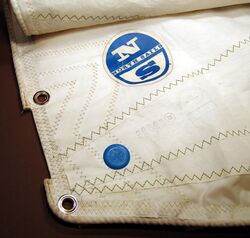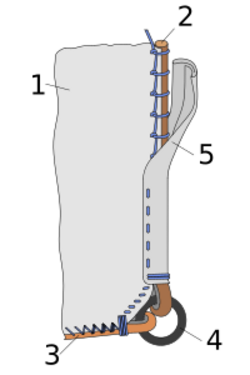Engineering:Bolt rope
A bolt rope[1] (Variants: "bolt-rope" and "boltrope", French: ralingue, Spanish: relinga,[2] Old Norse: *rár-línk, comprising rár genitive of rá "rope" and línk "edge of a sail "), is the rope that is sewn at the edges of the sail to reinforce them, or to fix the sail into a groove in the boom or in the mast.[1]
Fore-and-aft sails often have bolt ropes on the leading edge (luff) where they attach to the mast and the bottom edge (foot) where they attach to the boom, which provide the terms, "luff bolt rope" and "foot bolt rope". They also occur on the edges of sails suspended from a spar, such as for gaff, square and lateen rigs.[3]
Attachment and characteristics
Bolt ropes were described as early as 1847, when Robert Kipping addressed "bolt-rope" attachment for a variety of sails, using sewing techniques appropriate to each, in his book, The Elements of Sailmaking. He addressed the tradeoff between stiffness and flexibility to provide reinforcement without distorting the intended shape of the sail. He emphasized the need for the bolt rope not to affect the degree of slack on the leech (trailing edge) of a sail. He further emphasized that the rope must retain its original twist, as it is sewn in place, to avoid distorting the edge of the sail. He observed that, "Many a well-cut sail is spoiled by the roping."[1]
See also
References
- ↑ 1.0 1.1 1.2 Kipping, Robert (1847). The Elements of Sailmaking: Being a Complete Treatise on Cutting-out Sails, According to the Most Approved Methods in the Merchant Service.... F.W. Norie & Wilson. pp. 58–72. https://books.google.com/books?id=3n8EAAAAQAAJ&q=bolt-rope.
- ↑ Ricard Jaime Pérez (2006). La maniobra en els velers de creu. Edicions UPC, Barcelona. pp. 199. ISBN 9788483015902. http://www.histo.cat/1/Bolt-rope_ralinga_p-199.jpg.
- ↑ zu Mondfeld, Wolfram (2005). Historic Ship Models. New York: Sterling Publishing Company, Inc.. pp. 258. ISBN 1402721862. https://books.google.com/books?id=5nrXLkfLBGcC&q=bolt+rope+sail&pg=PA258.
Further reading
- Rousmaniere, John (June 1998). The Illustrated Dictionary of Boating Terms: 2000 Essential Terms for Sailors and Powerboaters (Paperback). W. W. Norton & Company. pp. 174. ISBN 0393339181. ISBN:978-0393339185
- Smyth, W. H.; Belcher, E. (1867). The sailor's word-book: An alphabetical digest of nautical terms, including some more especially military and scientific ... as well as archaisms of early voyagers, etc.. London: Blackie and Son. https://books.google.com/books?id=y7HqO9XAwk8C.
- A naval encyclopædia: comprising a dictionary of nautical words and phrases; biographical notices, and records of naval officers; special articles of naval art and science. Philadelphia: LR Hamersly & Co.. 1881. https://archive.org/stream/navalencyclopedia00hamerich/navalencyclopedia00hamerich_djvu.txt. Retrieved January 23, 2014. at Internet Archive
 |



